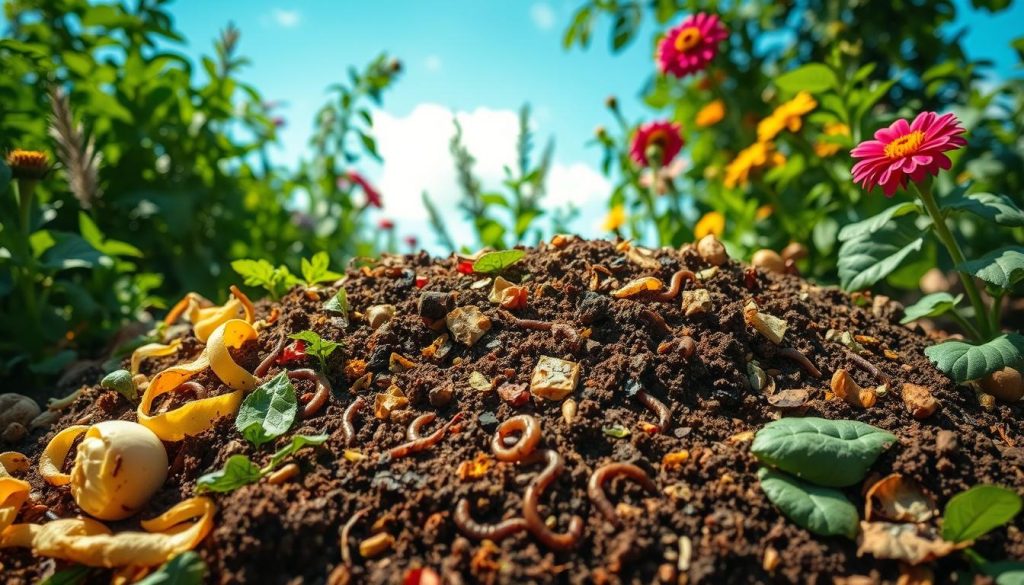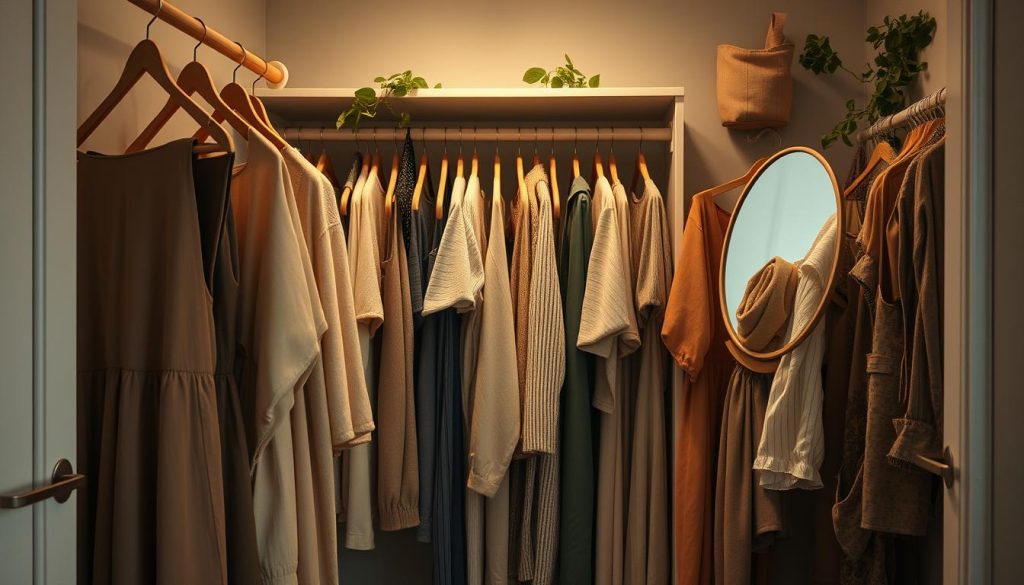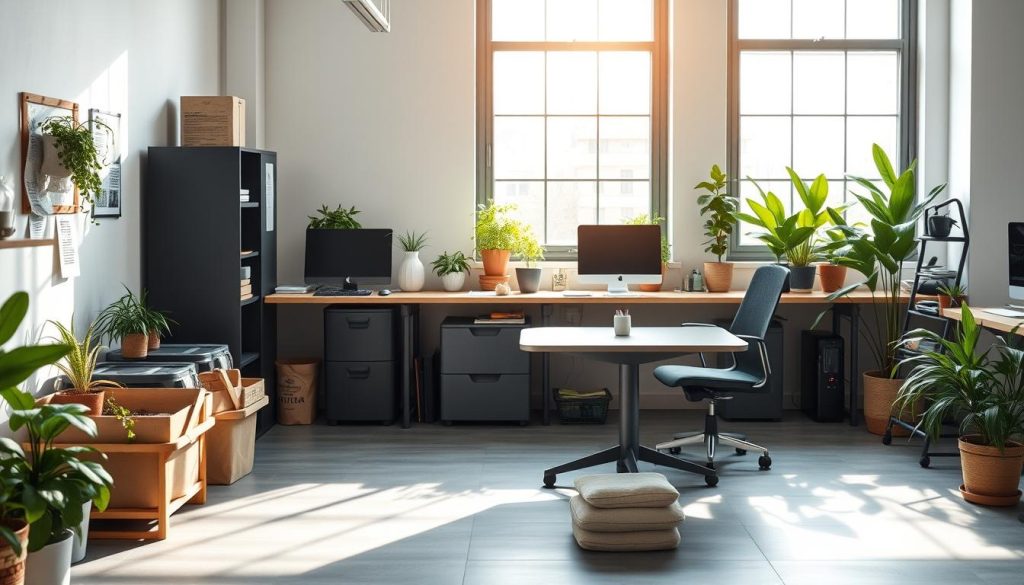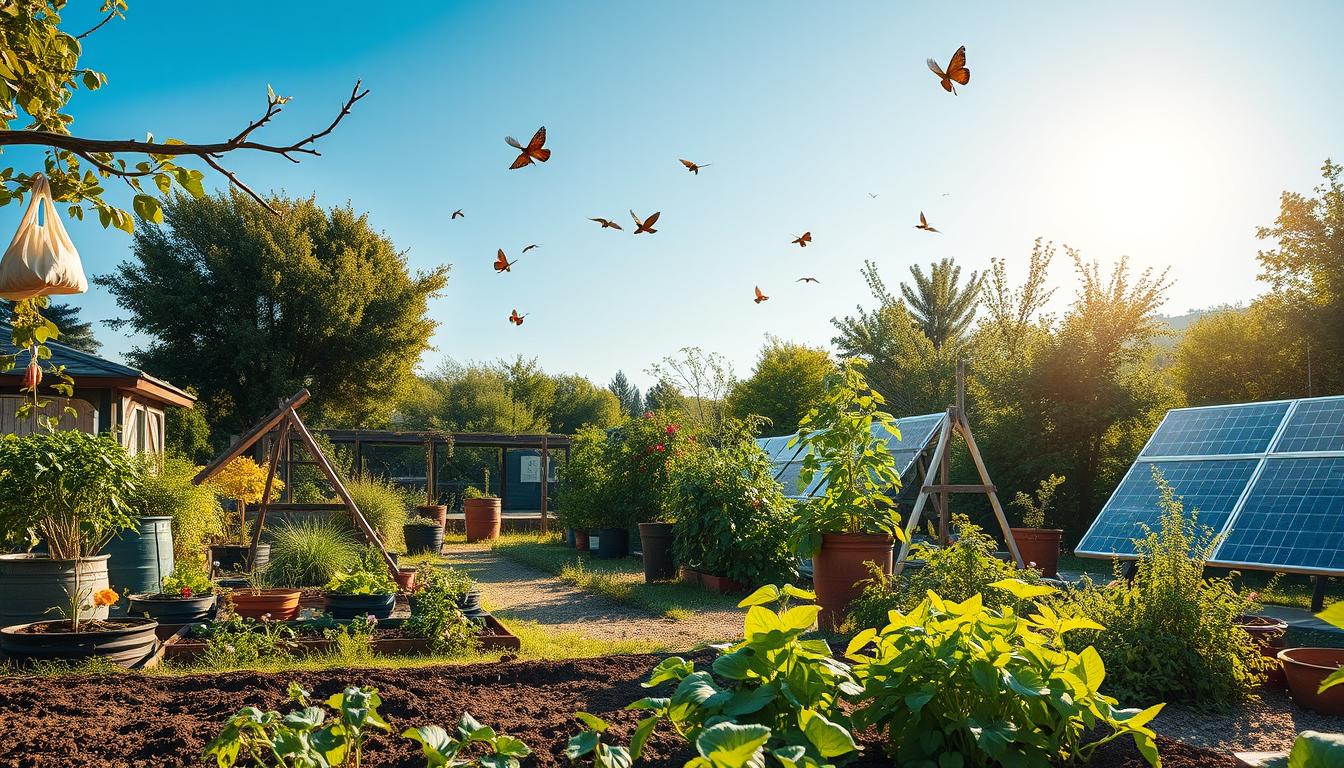I’m excited to guide you through the world of zero waste living. This journey is more than just reducing trash. It’s a path to a more fulfilling and eco-conscious lifestyle. By embracing sustainable living, we can make a real difference for our planet.
In this guide, I’ll share practical tips and insights to help you start your zero waste journey. We’ll cover the movement’s core principles and how to make eco-friendly habits part of your daily life. Small changes can lead to big impacts.
Ready to dive in? Let’s explore how adopting a zero waste lifestyle benefits you and the environment. Together, we’ll learn to minimize our ecological footprint and create a more sustainable future.
Understanding the Zero Waste Movement
I’ve been learning about the zero waste movement. It’s changing how I see waste and how we use things. This idea is all about reducing, reusing, and recycling to cut down on landfill waste.
What is Zero Waste?
Zero waste is a way of life that stops waste before it starts. It’s about changing how we use resources. We aim for a world where nothing is wasted, creating a circular economy.
The Environmental Impact of Waste
Our throw-away society harms the Earth a lot. Landfills and plastic pollution are big problems. By following zero waste, we can lessen our harm to the planet and protect nature.
Benefits of Adopting a Zero Waste Lifestyle
Choosing zero waste has many benefits for us and our communities. It’s not just good for the planet. It also makes our lives better.
| Benefit | Description |
|---|---|
| Reduced Carbon Footprint | Less waste means fewer emissions from landfills and production |
| Cost Savings | Buying in bulk and reusing items saves money long-term |
| Healthier Living | Less exposure to toxins from plastic and processed products |
| Community Impact | Inspires others to adopt sustainable practices |
Learning about the zero waste movement helps us move towards a greener future. It’s a challenge, but the benefits for our planet and us are huge.
Starting Your Zero Waste Journey: First Steps
Starting a zero waste journey can seem daunting, but it’s simpler than you might think. Begin with small steps and build up your efforts. Here are some easy ways to start your journey towards a minimalist lifestyle.
First, look at your current habits. I started by checking my trash and recycling bins. This helped me see where I could cut down on waste and set realistic goals.
Then, I replaced single-use items with reusable ones. Switching to a stainless steel water bottle and using my own shopping bags made a big difference. These changes greatly reduced my daily waste.
Adopting a minimalist mindset was key for me. I began to think twice about every purchase, asking if I really needed it. This not only cut down on waste but also saved me money and tidied up my space.
| Waste Category | Easy Swap | Environmental Impact |
|---|---|---|
| Plastic Bags | Reusable Tote Bags | Reduces plastic pollution in oceans |
| Disposable Coffee Cups | Reusable Travel Mug | Saves trees and reduces landfill waste |
| Plastic Straws | Stainless Steel Straws | Protects marine life from ingestion |
Don’t aim for perfection. Celebrating small wins kept me going on my zero waste journey. Every step towards a minimalist lifestyle helps our planet, and that’s something to be proud of.
Assessing Your Current Waste Production
To start my zero waste journey, I need to understand how much waste I’m producing. This involves conducting a waste audit, identifying areas for improvement, and setting realistic goals.
Conducting a Waste Audit
A waste audit helps me track my trash output. For one week, I collect and categorize all my waste. This includes everything from food scraps to packaging materials. By doing this, I gain insights into my consumption habits and waste patterns.
Identifying Areas for Improvement
After my waste audit, I analyze the results. I look for items that appear frequently in my trash. Single-use plastics, food waste, and unnecessary packaging are common culprits. These areas become my focus for waste reduction efforts.
Setting Realistic Goals
With a clear picture of my waste production, I set achievable goals. I start small, targeting one or two areas for improvement. For example, I might aim to reduce my plastic waste by 25% in the first month. As I progress, I adjust my goals to further minimize my environmental impact.
By assessing my current waste production, I lay the foundation for a successful zero waste journey. This process of conscious consumption helps me make informed decisions about my purchases and habits, leading to significant waste reduction over time.
Minimizing Single-Use Plastics in Your Daily Life
I’ve dedicated myself to cutting down on single-use plastics every day. It’s amazing how much plastic waste we create without even thinking about it. By making a few simple changes, we can greatly reduce our harm to the environment.
First off, I switched from plastic water bottles to a reusable one. It’s a tiny change, but it makes a big difference. I also carry my own coffee mug to cafes. Many places give discounts if you use your own cup!
Shopping for groceries is another chance to reduce plastic use. I now use cloth bags for fruits and veggies, and reusable containers for bulk items. It requires some planning, but it’s worth it for the planet.
| Single-Use Item | Eco-Friendly Alternative | Environmental Impact |
|---|---|---|
| Plastic Straw | Stainless Steel Straw | Prevents 584 straws from landfills yearly |
| Disposable Cutlery | Bamboo Utensil Set | Saves 466 plastic forks annually |
| Plastic Wrap | Beeswax Wrap | Eliminates 250 sq ft of plastic film per year |
In the bathroom, I’ve moved to bar soap and shampoo to avoid plastic bottles. For personal grooming, I use a safety razor instead of disposable ones. These small changes lead to big reductions in plastic use over time.
The aim isn’t to be perfect. It’s about making thoughtful choices and slowly adding eco-friendly options to our lives. Every little step we take brings us closer to a world without plastic.
Embracing Reusable Products: A Sustainable Alternative
Reusable products are key to my zero waste journey. They’ve greatly reduced my waste. Let’s look at some must-have items for a greener lifestyle.
Reusable Shopping Bags and Produce Bags
I always have reusable shopping bags ready. One set is in my car, and another in my purse. For fruits and veggies, I use mesh bags. These changes have cut down my plastic bag use a lot.
Water Bottles and Coffee Cups
Carrying a reusable water bottle is easy for me. I fill it up at home and refill it all day. For coffee, I use my travel mug. Many cafes give discounts for bringing your own cup!
Food Containers and Utensils
I’ve switched to glass containers for food storage. They’re great for leftovers and lunches. I also carry bamboo utensils for eating out, avoiding plastic cutlery.
| Reusable Item | Benefits | Estimated Annual Waste Reduction |
|---|---|---|
| Shopping Bags | Durable, washable, often made from recycled materials | 300-700 plastic bags |
| Water Bottle | Cost-effective, reduces plastic waste, keeps drinks cold/hot longer | 156-1,000 plastic bottles |
| Food Containers | Versatile, microwave-safe, prevents food waste | 500-1,000 disposable containers |
Using these reusable items has cut my waste a lot. It’s incredible how small changes can make a big difference. Every eco-friendly choice we make matters!
Mastering the Art of Composting

On my zero waste journey, I found composting to be a big help. It’s a great way to cut down on waste and make soil for gardens. Let’s look at some composting tips that can make a big difference.
Starting a compost pile is simple. First, pick a spot in your yard or get a compost bin. Then, layer your waste, mixing “green” (like fruit scraps) with “brown” (like dry leaves).
Here’s a simple guide to what you can compost:
- Fruit and vegetable scraps
- Coffee grounds and tea bags
- Eggshells
- Yard trimmings
- Shredded paper
Don’t forget to turn your compost pile often. This helps it break down faster. In a few months, you’ll have dark, rich compost for your garden.
If you live in an apartment, try vermicomposting (composting with worms). It’s small, doesn’t smell, and breaks down waste well.
By adding composting to your daily life, you’ll cut down on waste. You’ll also feel good about making something useful from trash.
Zero Waste Kitchen: Tips and Tricks
Starting a zero waste kitchen might seem hard, but it’s simpler than you think. Making a few changes can greatly reduce waste and save money. Let’s look at some easy tips to make your kitchen greener.
Buying in Bulk
Buying in bulk is a big help for a zero waste kitchen. I carry my own containers to stores that offer bulk. This cuts down on packaging and saves money on items like rice, beans, and nuts.
Meal Planning to Reduce Food Waste
Reducing food waste starts with planning meals. I plan my meals, make a shopping list, and stick to it. This stops me from buying too much and ensures I use all my produce. Plus, I find new ways to use leftovers instead of throwing them away.
DIY Kitchen Cleaners
Creating my own cleaners has been a big change. It’s cheaper and gets rid of plastic bottles. I use vinegar and water for cleaning and baking soda for scrubbing. These simple recipes keep my kitchen clean without harming the environment.
- Use glass jars for storage
- Opt for cloth napkins instead of paper
- Choose reusable dish cloths over paper towels
- Compost food scraps when possible
By following these tips, I’ve cut down a lot of waste in my kitchen. It’s a journey, but every step helps make my life more sustainable.
Sustainable Fashion: Building a Zero Waste Wardrobe

I’m excited to share my journey towards sustainable fashion and creating a zero waste wardrobe. It’s a key step in embracing a circular economy and reducing our environmental impact. Let’s explore how we can make mindful choices in our clothing habits.
When building a zero waste wardrobe, I focus on quality over quantity. I choose timeless pieces made from eco-friendly materials like organic cotton, hemp, and recycled fabrics. These items last longer and reduce the need for frequent replacements.
Thrift shopping has become my new favorite pastime. It’s amazing how many unique, high-quality items I find at second-hand stores. Not only does this save money, but it also extends the life cycle of clothing and supports the circular economy.
I’ve also discovered the joy of clothing swaps with friends. It’s a fun way to refresh our wardrobes without buying new items. Plus, it creates a sense of community around sustainable fashion.
| Sustainable Fashion Practice | Impact on Zero Waste Wardrobe |
|---|---|
| Choosing eco-friendly materials | Reduces environmental impact of production |
| Buying second-hand | Extends life cycle of clothing |
| Participating in clothing swaps | Minimizes new purchases |
| Supporting ethical brands | Promotes fair labor practices and sustainability |
By embracing these practices, I’ve significantly reduced my fashion waste. It’s a rewarding process that aligns with my values and contributes to a more sustainable future.
Zero Waste Personal Care and Beauty Routines
I’ve started using zero waste beauty practices and made my bathroom plastic-free. This journey has been about making simple changes. I’ve cut down on waste while keeping my self-care routines intact.
Plastic-Free Bathroom Essentials
My bathroom now has bamboo toothbrushes and glass soap dispensers. I’ve also switched to a safety razor and shampoo bars. These changes have greatly reduced my plastic use.
Natural and DIY Beauty Products
I enjoy making my own beauty products with natural ingredients. My top DIYs are a coconut oil and sugar scrub, and a honey and oatmeal face mask. These products are better for the planet and gentler on my skin.
Eco-Friendly Menstrual Products
I’ve switched to eco-friendly menstrual products, like a menstrual cup and reusable cloth pads. This has cut down my monthly waste a lot. These options are better for the planet and more comfortable and affordable too.
By adopting these zero waste beauty practices, I’ve found that caring for the environment can be enjoyable. It’s a simple way to help the planet without giving up self-care.
Reducing Waste in the Workplace

Creating a zero waste office might seem tough, but it’s key for a green workplace. I’ve found some great ways to cut down waste in any office.
Going paperless is a big step. By using digital documents and cloud storage, we can greatly reduce paper waste. When we do need to print, I choose double-sided and recycled paper.
Choosing the right office supplies is also important. I’ve switched to refillable pens and recycled notebooks. These changes help a lot in reducing our environmental impact.
- Use reusable cups and plates in the office kitchen
- Set up recycling stations for different materials
- Implement a composting system for food waste
Getting everyone on board is vital for a green office. I host workshops on reducing waste and start friendly competitions. This encourages everyone to join our zero waste mission.
By doing these things, we’re not just making our office cleaner. We’re also helping the planet. Every small step towards a zero waste office is a big step for the environment.
Zero Waste Journey: Overcoming Challenges and Staying Motivated
Starting a zero waste journey is tough. I’ve hit many eco-friendly hurdles. Some days, it feels like fighting a sea of plastic.
But every small step is important. When I make a mistake, I don’t get too hard on myself. I celebrate my progress and keep going.
Small victories motivate me to keep going. Finding new ways to reduce waste excites me. Connecting with others who share my goals also keeps me inspired.
To overcome challenges, I plan ahead. I always carry reusable items with me. At home, I set achievable goals and track my success. Seeing my progress motivates me.
It’s all about making progress, not being perfect. Every choice we make towards a cleaner planet counts.
